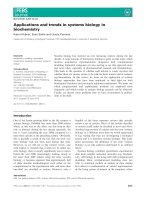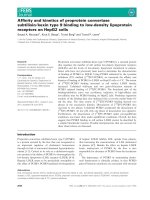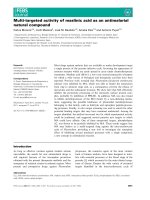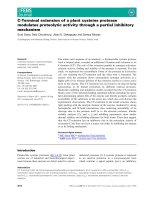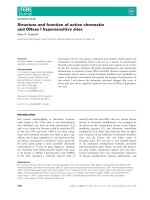Tài liệu Báo cáo khoa học: "NLP-based Tweet Search" pdf
Bạn đang xem bản rút gọn của tài liệu. Xem và tải ngay bản đầy đủ của tài liệu tại đây (681.39 KB, 6 trang )
Proceedings of the 50th Annual Meeting of the Association for Computational Linguistics, pages 13–18,
Jeju, Republic of Korea, 8-14 July 2012.
c
2012 Association for Computational Linguistics
QuickView: NLP-based Tweet Search
Xiaohua Liu
‡ †
, Furu Wei
†
, Ming Zhou
†
, Microsoft QuickView Team
†
‡
School of Computer Science and Technology
Harbin Institute of Technology, Harbin, 150001, China
†
Microsoft Research Asia
Beijing, 100190, China
†
{xiaoliu, fuwei, mingzhou,qv}@microsoft.com
Abstract
Tweets have become a comprehensive repos-
itory for real-time information. However, it
is often hard for users to quickly get informa-
tion they are interested in from tweets, ow-
ing to the sheer volume of tweets as well as
their noisy and informal nature. We present
QuickView, an NLP-based tweet search plat-
form to tackle this issue. Specifically, it ex-
ploits a series of natural language process-
ing technologies, such as tweet normalization,
named entity recognition, semantic role label-
ing, sentiment analysis, tweet classification, to
extract useful information, i.e., named entities,
events, opinions, etc., from a large volume
of tweets. Then, non-noisy tweets, together
with the mined information, are indexed, on
top of which two brand new scenarios are en-
abled, i.e., categorized browsing and advanced
search, allowing users to effectively access
either the tweets or fine-grained information
they are interested in.
1 Introduction
Tweets represent a comprehensive fresh informa-
tion repository. However, users often have diffi-
culty finding information they are interested in from
tweets, because of the huge number of tweets as well
as their noisy and informal nature. Tweet search,
e.g., Twitter
1
, is a kind of service aiming to tackle
this issue. Nevertheless, existing tweet search ser-
vices provide limited functionality. For example, in
Twitter, only a simple keyword-based search is sup-
1
/>ported, and the returned list often contains meaning-
less results.
This demonstration introduces QuickView, which
employs a series of NLP technologies to extract
useful information from a large volume of tweets.
Specifically, for each tweet, it first conducts nor-
malization, followed by named entity recognition
(NER). Then it conducts semantic role labeling
(SRL) to get predicate-argument structures, which
are further converted into events, i.e., triples of who
did what. After that, it performs sentiment analysis
(SA), i.e., extracting positive or negative comments
about something/somebody. Next, tweets are clas-
sified into predefined categories. Finally, non-noisy
tweets together with the mined information are in-
dexed.
On top of the index, QuickView enables two brand
new scenarios, allowing users to effectively access
the tweets or fine-grained information mined from
tweets.
Categorized Browsing. As illustrated in Figure
1(a), QuickView shows recent popular tweets, enti-
ties, events, opinions and so on, which are organized
by categories. It also extracts and classifies URL
links in tweets and allows users to check out popular
links in a categorized way.
Advanced Search. As shown in Figure 1(b), Quick-
View provides four advanced search functions: 1)
search results are clustered so that tweets about the
same/similar topic are grouped together, and for
each cluster only the informative tweets are kept;
2) when the query refers to a person or a company,
two bars are presented followed by the words that
strongly suggest opinion polarity. The bar’s width
13
is proportional to the number of associated opin-
ions; 3) similarly, the top six most frequent words
that most clearly express event occurrences are pre-
sented; 4) users can search tweets with opinions
or events, e.g., search tweets containing any posi-
tive/negative opinion about “Obama” or any event
involving “Obama”.
The implementation of QuickView requires adapt-
ing existing NLP components trained on formal
texts, which often performs poorly on tweets. For
example, the average F1 of the Stanford NER
(Finkel et al., 2005) drops from 90.8% (Ratinov
and Roth, 2009) to 45.8% on tweets, while Liu et
al. (2010) report that the F1 score of a state-of-
the-art SRL system (Meza-Ruiz and Riedel, 2009)
falls to 42.5% on tweets as apposed to 75.5% on
news. However, the adaptation of those components
is challenging, owing to the lack of annotated tweets
and the inadequate signals provided by a noisy and
short tweet. Our general strategy is to leverage ex-
isting resources as well as unsupervised or semi-
supervised learning methods to reduce the labeling
efforts, and to aggregate as much evidence as pos-
sible from a broader context to compensate for the
lack of information in a tweet.
This strategy is embodied by various components
we have developed. For example, our NER com-
ponent combines a k-nearest neighbors (KNN) clas-
sifier, which collects global information across re-
cently labeled tweets with a Conditional Random
Fields (CRF) labeler, which exploits information
from a single tweet and the gazetteers. Both the
KNN classifier and the CRF labeler are repeatedly
retrained using the results that they have confidently
labeled. The SRL component caches and clusters
recent labeled tweets, and aggregates information
from the cluster containing the tweet. Similarly, the
classifier considers not only the current tweet but
also its neighbors in a tweet graph, where two tweets
are connected if they are similar in content or have a
tweet/retweet relationship.
QuickView has been internally deployed, and re-
ceived extremely positive feedback. Experimental
results on a human annotated dataset also indicate
the effectiveness of our adaptation strategy.
Our contributions are summarized as follows.
1. We demonstrate QuickView, an NLP-based
tweet search. Different from existing methods,
it exploits a series of NLP technologies to ex-
tract useful information from a large volume
of tweets, and enables categorized browsing
and advanced search scenarios, allowing users
to efficiently access information they are inter-
ested in from tweets.
2. We present core components of QuickView, fo-
cusing on how to leverage existing resources
and technologies as well as how to make up
for the limited information in a short and often
noisy tweet by aggregating information from a
broader context.
The rest of this paper is organized as follows. In
the next section, we introduce related work. In Sec-
tion 3, we describe our system. In Section 4, we
evaluate our system. Finally, Section 5 concludes
and presents future work.
2 Related Work
Information Extraction Systems. Essentially,
QuickView is an information extraction (IE) system.
However, unlike existing IE systems, such as Evita
(Saur
´
ı et al., 2005), a robust event recognizer for QA
system, and SRES (Rozenfeld and Feldman, 2008),
a self-supervised relation extractor for the web, it
targets tweets, a new genre of text, which are short
and informal, and its focus is on adapting existing IE
components to tweets.
Tweet Search Services. A couple of tweet search
services exist, including Twitter, Bing social search
2
and Google social search
3
. Most of them provide
only keyword-based search interfaces, i.e., return-
ing a list of tweets related to a given word/phrase.
In contrast, our system extracts fine-grained in-
formation from tweets and allows a new end-to-
end search experience beyond keyword search, such
as clustering of search results, and search with
events/opinions.
NLP Components. The NLP technologies adopted
in our system , e.g., NER, SRL and classification,
have been extensively studied on formal text but
rarely on tweets. At the heart of our system is
the re-use of existing resources, methodologies as
2
/>3
/>14
(a) A screenshot of the categorized browsing scenario.
(b) A screenshot of the advanced search scenario.
Figure 1: Two scenarios of QuickView.
well as components, and the the adaptation of them
to tweets. The adaptation process, though varying
across components, consists of three common steps:
1) annotating tweets; 2) defining the decision con-
text that usually involves more than one tweet, such
as a cluster of similar tweets; and 3) re-training mod-
els (often incrementally) with both conventional fea-
tures and features derived from the context defined
in step 2.
3 System Description
We first give an overview of our system, then present
more details about NER and SRL, as two represen-
tative core components, to illustrate the adaptation
process.
3.1 Overview
Architecture. QuickView can be divided into four
parts, as illustrated in Figure 2. The first part in-
cludes a crawler and a buffer of raw tweets. The
crawler repeatedly downloads tweets using the Twit-
ter APIs, and then pre-filters noisy tweets using
some heuristic rules, e.g., removing a tweet if it is
too short, say, less than 3 words, or if it contains
any predefined banned word. At the moment, we
focus on English tweets, so non-English tweets are
filtered as well. Finally, the un-filtered are put into
the buffer.
The second part consists of several tweet extrac-
tion pipelines. Each pipeline has the same configura-
tion, constantly fetching a tweet from the raw tweet
buffer, and conducting the following processes se-
15
Figure 2: System architecture of QuickView.
quentially: 1) normalization; 2) parsing including
part-of-speech (POS), chunking, and dependency
parsing; 3) NER; 4) SRL; 5) SA and 6) classifica-
tion. The normalization model identifies and cor-
rects ill-formed words. For example, after normal-
ization, “loooove” in “···I loooove my icon···”
will be transformed to “love”. A phrase-based trans-
lation system without re-ordering is used to imple-
ment this model. The translation table includes man-
ually compiled ill/good form pairs, and the language
model is a trigram trained on LDC data
4
using
SRILM (Stolcke, 2002). The OpenNLP
5
toolkit
is directly used to implement the parsing model.
In future, the parsing model will be re-trained us-
ing annotated tweets. The SA component is imple-
mented according to Jiang et al. (2011), which incor-
porates target-dependent features and considers re-
lated tweets by utilizing a graph-based optimization.
The classification model is a KNN-based classifier
that caches confidently labeled results to re-train it-
self, which also recognizes and drops noisy tweets.
4
?cata-
logId=LDC2005T12
5
/>Each processed tweet, if not identified as noise, is
put into a shared buffer for indexing.
The third part is responsible for indexing and
querying. It constantly takes from the indexing
buffer a processed tweet, which is then indexed with
various entries including words, phrases, metadata
(e.g., source, publish time, and account), named en-
tities, events, and opinions. On top of this, it answers
any search request, and returns a list of matched re-
sults, each of which contains both the original tweet
and the extracted information from that tweet. We
implement an indexing/querying engine similar to
Lucene
6
in C#. This part also maintains a cache of
recent processed tweets, from which the following
information is extracted and indexed: 1) top tweets;
2) top entities/events/opinions in tweets; and 3)
top accounts. Whether a tweet/entity/event/opinion
ranks top depends on their re-tweeted/mentioned
times as well as its publisher, while whether an ac-
count is top relies on the number of his/her followers
and tweets.
The fourth part is a web application that returns
related information to end users according to their
browsing or search request. The implementation of
the web application is organized with the model-
view-control pattern so that other kinds of user in-
terfaces, e.g., a mobile application, can be easily im-
plemented.
Deployment. QuickView is deployed into 5 work-
stations
7
including 2 processing pipelines, as illus-
trated in Table 1. The communication between com-
ponents is through TCP/IP. On average, it takes 0.01
seconds to process each tweet, and in total about
10 million tweets are indexed every day. Note that
QuickView’s processing capability can be enhanced
in a straightforward manner by deploying additional
pipelines.
3.2 Core Components
Because of limited space, we only discuss two core
components of QuickView: NER and SRL.
NER. NER is the task of identifying mentions of
rigid designators from text belonging to named-
entity types such as persons, organizations and loca-
tions. Existing solutions fall into three categories: 1)
6
/>7
Intel
Xeon
2.33 CPU 5140 @2.33GHz, 4G of RAM,
OS of Windows Server 2003 Enterprise X64 version
16
Table 1: Current deployment of QuickView.
Workstation Hosted components
#1 Crawler,Raw tweet buffer
#2, 3 Process pipeline
#4 Indexing Buffer, Indexer/Querier
#5 Web application
the rule-based (Krupka and Hausman, 1998); 2) the
machine learning based (Finkel and Manning, 2009;
Singh et al., 2010); and 3) hybrid methods (Jansche
and Abney, 2002). With the availability of annotated
corpora, such as ACE05, Enron and CoNLL03, the
data-driven methods become the dominating meth-
ods. However, because of domain mismatch, cur-
rent systems trained on non-tweets perform poorly
on tweets.
Our NER system takes three steps to address
this problem. Firstly, it defines those recently la-
beled tweets that are similar to the current tweet
as its recognition context, under which a KNN-
based classifier is used to conduct word level clas-
sification. Following the two-stage prediction ag-
gregation methods (Krishnan and Manning, 2006),
such pre-labeled results, together with other con-
ventional features used by the state-of-the-art NER
systems, are fed into a linear CRF models, which
conducts fine-grained tweet level NER. Secondly,
the KNN and CRF model are repeatedly retrained
with an incrementally augmented training set, into
which highly confidently labeled tweets are added.
Finally, following Lev Ratinov and Dan Roth
(2009), 30 gazetteers are used, which cover common
names, countries, locations, temporal expressions,
etc. These gazetteers represent general knowledge
across domains, and help to make up for the lack of
training data.
SRL. Given a sentence, the SRL component identi-
fies every predicate, and for each predicate further
identifies its arguments. This task has been exten-
sively studied on well-written corpora like news, and
a couple of solutions exist. Examples include: 1)
the pipelined approach, i.e., dividing the task into
several successive components such as argument
identification, argument classification, global infer-
ence, etc., and conquering them individually (Xue,
2004; Koomen et al., 2005); 2) sequentially labeling
based approach (M
`
arquez et al., 2005), i.e., label-
ing the words according to their positions relative
to an argument (i.e., inside, outside, or at the be-
ginning); and 3) Markov Logic Networks (MLN)
based approach (Meza-Ruiz and Riedel, 2009),
i.e., simultaneously resolving all the sub-tasks using
learnt weighted formulas. Unsurprisingly, the per-
formance of the state-of-the-art SRL system (Meza-
Ruiz and Riedel, 2009) drops sharply when applied
to tweets.
The SRL component of QuickView is based on
CRF, and uses the recently labeled tweets that are
similar to the current tweet as the broader context.
Algorithm 1 outlines its implementation, where:
train denotes a machine learning process to get a
labeler l, which in our work is a linear CRF model;
the cl uster function puts the new tweet into a clus-
ter; the label function generates predicate-argument
structures for the input tweet with the help of the
trained model and the cluster; p, s and cf denote a
predicate, a set of argument and role pairs related to
the predicate and the predicted confidence, respec-
tively. To prepare the initial clusters required by the
SRL component as its input, we adopt the predicate-
argument mapping method (Liu et al., 2010) to
get some automatically labeled tweets, which (plus
the manually labeled tweets) are then organized into
groups using a bottom-up clustering procedure.
It is worth noting that: 1) our SRL component
uses the general role schema defined by PropBank,
which includes core roles such as A0, A1 (usually
indicating the agent and patient of the predicate, re-
spectively), and auxiliary roles such as AM-TMP
and AM-LOC (representing the temporal and loca-
tion information of the predicate, respectively); 2)
only verbal predicates are considered, which is con-
sistent with most existing SRL systems; and 3) fol-
lowing M
`
arquez et al. (2005), it conducts word level
labeling.
4 Evaluation
Overall Performance. We provide a textbox in the
home page of QuickView to collect feedback. We
have got 165 feedbacks, of which 85.5% are posi-
tive. The main complaint is related to the quality of
the extracted information.
Core Components. We manually labeled the POS,
17
Algorithm 1 SRL of QuickView.
Require: Tweet stream i;clusters cl;output stream o.
1: Initialize l, the CRF labeler: l = train(cl).
2: while Pop a tweet t from i and t ̸= null do
3: Put t to a cluster c: c = cluster(cl, t).
4: Label t with l:(t, {(p, s, cf)}) = label(l, c, t).
5: Update cluster c with labeled results
(t, {(p, s, cf)}).
6: Output labeled results (t, {(p, s, cf)}) to o.
7: end while
8: return o.
NER, SRL and SA information for about 10,000
tweets, based on which the NER and SRL com-
ponents are evaluated. Experimental results show
that: 1) our NER component achieves an average
F1 of 80.2%, as opposed to 75.4% of the baseline,
which is a CRF-based system similar to Ratinov and
Roth’s (2009) but re-trained on annotated tweets;
and 2) our SRL component gets an F1 of 59.7%, out-
performing both the state-of-the-art system (Meza-
Ruiz and Riedel, 2009) (42.5%) and the system of
Liu et al. (2010) (42.3%), which is trained on au-
tomatically annotated news tweets (tweets reporting
news).
5 Conclusions and Future work
We have described the motivation, scenarios, archi-
tecture, deployment and implementation of Quick-
View, an NLP-based tweet search. At the heart of
QuickView is the adaptation of existing NLP tech-
nologies, e.g., NER, SRL and SA, to tweets, a new
genre of text, which are short and informal. We
have illustrated our strategy to tackle this challeng-
ing task, i.e., leveraging existing resources and ag-
gregating as much information as possible from a
broader context, using NER and SRL as case stud-
ies. Preliminary positive feedback suggests the use-
fulness of QuickView and its advantages over exist-
ing tweet search services. Experimental results on
a human annotated dataset indicate the effectiveness
of our adaptation strategy.
We are improving the quality of the core compo-
nents of QuickView by labeling more tweets and ex-
ploring alternative models. We are also customizing
QuickView for non-English tweets. As it progresses,
we will release QuickView to the public.
References
Jenny Rose Finkel and Christopher D. Manning. 2009.
Nested named entity recognition. In EMNLP, pages
141–150.
Jenny Rose Finkel, Trond Grenager, and Christopher
Manning. 2005. Incorporating non-local information
into information extraction systems by gibbs sampling.
In ACL, pages 363–370.
Martin Jansche and Steven P. Abney. 2002. Informa-
tion extraction from voicemail transcripts. In EMNLP,
pages 320–327.
Long Jiang, Mo Yu, Ming Zhou, and Xiaohua Liu. 2011.
Target-dependent twitter sentiment classification. In
ACL.
Peter Koomen, Vasin Punyakanok, Dan Roth, and Wen-
tau Yih. 2005. Generalized inference with multi-
ple semantic role labeling systems. In CONLL, pages
181–184.
Vijay Krishnan and Christopher D. Manning. 2006. An
effective two-stage model for exploiting non-local de-
pendencies in named entity recognition. In ACL, pages
1121–1128.
George R. Krupka and Kevin Hausman. 1998. Isoquest:
Description of the netowl
T M
extractor system as used
in muc-7. In MUC-7.
Xiaohua Liu, Kuan Li, Bo Han, Ming Zhou, Long Jiang,
Zhongyang Xiong, and Changning Huang. 2010. Se-
mantic role labeling for news tweets. In Coling, pages
698–706.
Llu
´
ıs M
`
arquez, Pere Comas, Jes
´
us Gim
´
enez, and Neus
Catal
`
a. 2005. Semantic role labeling as sequential
tagging. In CONLL, pages 193–196.
Ivan Meza-Ruiz and Sebastian Riedel. 2009. Jointly
identifying predicates, arguments and senses using
markov logic. In NAACL, pages 155–163.
Lev Ratinov and Dan Roth. 2009. Design challenges
and misconceptions in named entity recognition. In
CoNLL, pages 147–155.
Benjamin Rozenfeld and Ronen Feldman. 2008. Self-
supervised relation extraction from the web. Knowl.
Inf. Syst., 17:17–33, October.
Roser Saur
´
ı, Robert Knippen, Marc Verhagen, and James
Pustejovsky. 2005. Evita: A robust event recognizer
for qa systems. In EMNLP, pages 700–707.
Sameer Singh, Dustin Hillard, and Chris Leggetter. 2010.
Minimally-supervised extraction of entities from text
advertisements. In HLT-NAACL, pages 73–81.
Andreas Stolcke. 2002. SRILM – an extensible language
modeling toolkit. InICSLP, volume 2, pages 901–904.
Nianwen Xue. 2004. Calibrating features for seman-
tic role labeling. In In Proceedings of EMNLP 2004,
pages 88–94.
18


